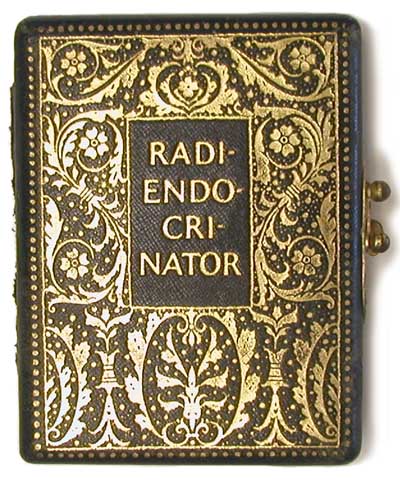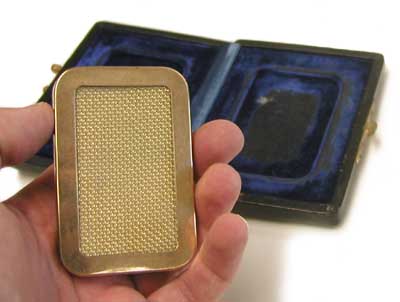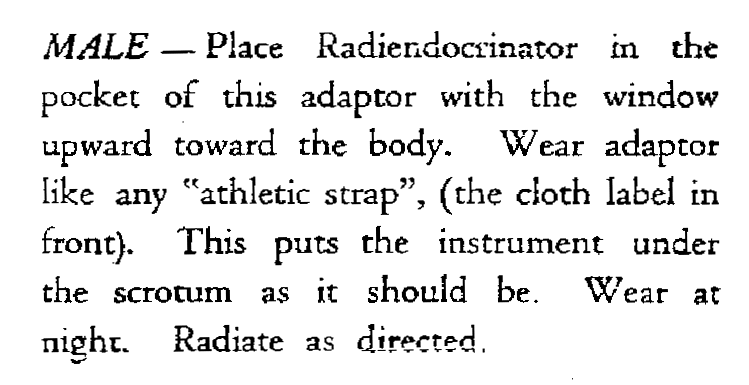The Radiendocrinator (ca. 1924-1929)

According to American Endocrine Laboratories, the Radiendocrinator (pronounced Ra-di-en-do-cri-na-tor) was "the last word in scientific manufacture." It had to be to justify its $150 price tag. The latter, believe it or not, was the lowest it ever sold for. Initially, the Radiendocrinator was priced at $1,000.
Check out the beautiful dark blue embossed leatherette case! Opening it up, you see the gold plated Radiendocrinator nestled in its velvet lined pocket (photo below left).

Size: 2" x 3"
Exposure rates: Nothing above background is detectable now that the radium source has been removed. Prior to the removal of the source I believe the beta-gamma GM detector response was ca. 200 mR/hr on contact.
The Radiendocrinator was intended to be placed over the endocrine glands, "which have so masterful a control over life and bodily health."
As one example of its use, men were advised as follows:

The Radiendocrinator in the above photo was sufficiently radioactive that I had to remove the source before it could be put on display. The source consisted of seven or so radium-soaked blotter-like pieces of paper about the size and shape of a credit card. These were covered with a thin piece of clear plastic and two gold-wire screens. As might be expected, the device leaked with the result that the inside of the case is mildly contaminated.
American Endocrine Laboratories occupied several locations in New York City. The earliest address that I have for them was 15 West 44th Street (ca. 1923-1925). The next address that I know of was 270 Madison Avenue (ca. 1925-1926). Their last location was 113 West 42nd Street (ca. 1927-1930).
The company was the creation of William J. Bailey, but at some point he and it seem to have parted ways. The split might have occurred in 1925 or 1926 when he began producing Radithor, his most infamous product, at Bailey Radium Laboratories in East Orange, New Jersey. Read about William Bailey and Radithor.
Ward (Howard?) Leathers, the other key player in the American Endocrine Laboratories company, was an attorney. When Bailey left, Leathers kept American Endocrine Laboratories going. The only other name I can directly connect to the company is S. Kerew who handled the correspondence.
At one time American Endocrine Laboratories occupied the same office as Vitamon Corporation (Holmes, 2010). The latter company, whose featured product was Mastin’s Vitamon health tablets, was owned by Dr. Herman H. Rubin. It was Rubin’s business interests in patent medicines and devices like the Radiendocrinator resulted in him being expelled from the Medical Societies of the State of New York and the County of New York in March of 1924.
Rubin had an ambiguous relationship with William Bailey and American Endocrine Laboratories. Although he denied that he had a business interest in the company or that he sold the Radiendocrinator, American Endocrine Laboratories distributed at least three of Rubin’s books:Scientific Rejuvenation Without Operation,The New Science of Endocrinology in its Relation to RejuvenationandThe Mysterious Glands. Furthermore, he admitted that he used the device in his medical practice. When Rubin prescribed it to patients, he did so through Radisante Endocrine Laboratories (366 Fifth Avenue) who called it the “Rubin Endocrinator.”
Just as the Endocrinator was another name for the Radiendocrinator, Radisante Endocrine Laboratories was another name for American Endocrine Laboratories. Perhaps the fictitious distinctions allowed Rubin to maintain his distance from American Endocrine Laboratories. In 1926, Radisante Endocrine Laboratories changed their name to U.S. Gamma laboratories.
The earliest reference I have to the Radiendocrinator and American Endocrine Laboratories isThe Radiendocrinator,a booklet with a copyright date of 1923. That same year, Rubin published two books mentioning the Radiendocrinator:Scientific Rejuvenation Without Operation, andThe New Science of Endocrinology in its Relation to Rejuvenation.
My best guess is that Rubin “invented” the first version of the device, sometimes referred to as the "Clinic Type Radiendocrinator." A 1924 newspaper advertisement/article featuring William Bailey included a photograph of Rubin standing next to one. It was pretty substantial: about the size of a football, egg-shaped and mounted on a stand. Several other newspaper articles, these ones featuring Rubin, included similar photographs.
The problem with the Clinic Type Radiendocrinator was that it couldn’t be mass produced and sold. Perhaps that is what inspired either Rubin or Bailey to create the “RS” or “Standard” version of the Radiendocrinator, the one in the ORAU collection (top photo). As it was described at the time: “The newest type of Radiendocrinator for home use is a very small device and comes together with adaptors for attaching it to body.”
You could wear it wherever and whenever you wanted: at home, at work, at play. Promotional booklets showed attractive men and women wearing nothing but the Radiendocrinator (strapped to their head, neck, back, and other places).
When American Endocrine Laboratories closed its doors (ca. April 25, 1930), Ward Leathers was identified as its sole proprietor. A document listing the company’s final assets and liabilities described the American Endocrine Laboratories as a manufacturer of special machinery—I suppose you could call the Radiendocrinator "special machinery." The company’s net worth, on paper anyway, was almost $85,000. Not bad.
The aforementioned document indicated that the American Endocrine Laboratories began in March of 1922 and that 1929 was the last year that they actually manufactured anything.
Donated by the Texas Department of Health, courtesy of Robin Houston.
Reference
Holmes, R.W. Substance of the Sun: The Cultural History of Radium Medicines in America. Dissertation. University of texas at Austin. 2010.
